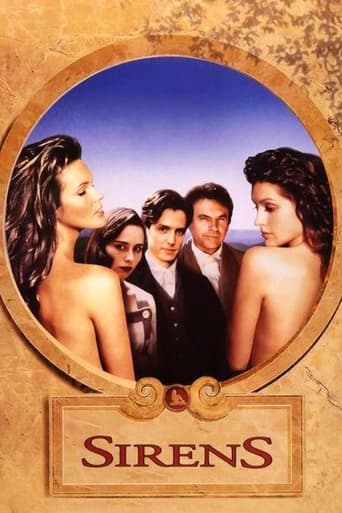Wuchak
Released in 1993, "Sirens" is about a young Anglican priest (Hugh Jackman) and his wife, Estella (Tara Fitzgerald), who are sent by the church to Norman Lindsay's estate in the Blue Mountains of New South Wales circa 1930 to talk him out of exhibiting what they consider a blasphemous painting. Estella, who's sexually repressed due to her sect's Victorian legalism, experiences a sexual awakening after befriending the (mostly) nude models on Lindsay's breathtaking estate (Elle Macpherson, Kate Fischer, Portia de Rossi and Pamela Rabe). Mark Gerber has a fairly significant role as a blind/mute handyman hunk.Norman Lindsay is considered one of Australia's greatest artists -- a painter, illustrator, sculptor and writer -- who didn't pass away till 1969. He was known for his artistic diligence and high output. Although he did a lot of nude works they're hardly pornographic (google them). This plus the fact that his mother was the daughter of Wesleyen missionaries makes it doubtful that he was ever intentionally blasphemous. Some of his works were considered controversial simply due to lingering Victorian mores at the time.Although the movie poster and DVD cover feature Grant and Macphereson, the movie's really about Fitzgerald's character, Estella, and her potentially positive transformation despite possible moral failure. Speaking of the poster/cover, the shot of Grant is horrible as he looks like a butch lesbian more than he does himself (no offense to butch lesbians).Also speaking of the DVD cover, the film has been mis-advertised as a comedy-drama when actually it's not a comedy at all. Although there are a few amusing moments, this is squarely an adult drama about Lindsay's awe-inspiring estate providing the liberating environment for Estella from the cage of religious legalism. I'm not necessarily saying that everything that goes on at the estate is good or morally healthy -- in fact, I'm not saying that at all -- but Lindsay was an artist who naturally rejected all confining parameters; as such, his manor and the surrounding wilderness provide the freedom-inducing atmosphere necessary for Estella's succor from Victorian sterility.Fitzgerald, Grant and Sam Neill (Lindsay) are excellent in their roles and Macphereson gained weight for her first film in order to properly depict one of Lindsay's voluptuous models. As far as the models go, Portia de Rossi steals the show as the more-modest Giddy.Due to the many references to the Titanic and various other sea tragedies some have erroneously interpreted the film as the delusions of a victim of the Titanic, but this is canceled out by the fact that the story takes place roughly 18 years after that shipwreck and also because the filmmakers themselves deny such a claim on the DVD commentary. This isn't to say, however, that a viewer can't interpret the film in this creative manner because film, like all artistic works, are open to the viewer's personal interpretation.The shots of the Titanic are actually metaphors for the "iceberg" of female sexuality that the "Titanic" of Estella's sexual repression was heading for. The message of the film is simple yet powerful: All women are sirens, even those locked in a confining zeitgeist, organization or belief system. In light of the story's context and the protagonist's character arc, the film is no more anti-Christian than the story of David and Bathsheba or Tamar and Judah (Genesis 38) in the Bible.As far as comparisons go, "Sirens" stands alone, but the contemporaneous "The Piano" isn't far off. They're both adult historical dramas released the same year and their stories take place in the same part of the world. While "The Piano" is certainly a quality adult drama, "Sirens" edges it out by quite a margin.The film runs a short-but-sweet 98 minutes and was shot on Lindsay's estate in Faulconbridge, New South Wales, and the surrounding Blue Mountains area.GRADE: A-
MBunge
This film covers up a rather muddled main story with a lot of charm and a lot of nudity. It works pretty well as a travelogue of both the Australian countryside and Elle Macpherson's breasts, but it depends too much on the audience coming into the film with a certain predisposition.Anthony Campion (Hugh Grant) is an English clergyman in the 1930s who's been sent to Australia to deal with a controversial artist. The paintings of Norman Lindsay (Sam Neill) splash nudity and blasphemy across the canvas and Campion is sent to ask him to provide some less provocative work for an exhibition. Campion and his wife Estella (Tara Fitzgerald) travel to Lindsay's home and spend several days there, Campion arguing with Lindsay and Estella getting caught up with the sexually precocious models that live with Lindsay. Essentially, the movie is about Estella overcoming her button down and conventional morality through the Sapphic-tinged attentions of a model named Sheela (Elle Macpherson) and the lovelorn neediness of another model named Giddy (Portia De Rossi). A handyman named Devlin (Mark Gerber), who seems to be straight out of a Harlequin romance novel, also figures into the mix.This definitely isn't a movie you'll enjoy because of its story. It establishes Campion and Lindsay quite well as a devout but cultured man of God and an intellectual version of Hugh Hefner, respectively. Those two characters don't do very much, though. The other characters are either broadly or obviously drawn and are more like props than people. Even Estella, who's clearly becomes the main character in the movie, isn't defined as much more than a typical, middle class Englishwoman of the early 20th century, with all the generic sort of reserve and pluck than implies.Sirens is supposed to be about the sensual awakening of Estella. The problem is it never bothers to explain why she needs to be awoken. Outside of a bout of passionless sex with their pajamas on that happens late in the story, the movie doesn't explore or explain or display what's wrong with the way Campion and Estella are. Indeed, Campion is put forth as a well-adjusted Christian man while the audience is left to merely assume that Estella is repressed and unhappy. By not establishing that something is disordered or unhealthy with Estella, the film takes away any sense of purpose or significance to her journey to sexual fulfillment. It's like the audience is supposed to naturally understand there's something terribly leaden and cold about being a middle class Englishwoman in the early 20th century.I'm not sure Sirens would be much of a film if it weren't for the plentiful nudity on display but there is a lot of it, it's high quality and there's something for both genders and most orientations. The nakedness is of a more artistic than erotic quality, however. It's also interesting to see a young Hugh Grant play the exact same sort of character he's played his entire career, but with an air of more confidence and maturity. It makes you realize that the stock Hugh Grant character has somewhat aged in reverse, becoming more insecure and befuddled as Grant himself got older.The other actors all do a fine job and it's surprising that Elle Macpherson didn't get more roles after this film. In addition to being stunning, she has a real on screen presence and charisma. You always notice her when she's in a scene, and not just because she's beautiful and without clothes.Sirens has a sense of style and is not at all heavy-handed with its theme of sexual liberation. It's more diverting than engrossing, but if you like period pieces about unusual people and their odd lives (with oodles of bare flesh thrown in), you should give this film a try.
apverhoef
This film is not simply about eroticism. You cannot judge this film by this subject alone. Obvious it is about the contradiction between sexual seduction and Christian morality some hundred years ago. But it is also a homage to 19the century (English) symbolist sensuality-painting. For instance Opelia (Millais 1852). The 'fatale women' were also an important subject in this time. That's why the film is called Sirens. The 'paintings' and the female actors shown, reminds me most of Belgian painter and illustrator Rops (1833-1898). The film seems in someway anachronistic, because in the time the cars you see in the film, the artists painted in a more modern way. In the time of these English painters the cars were coaches. Reading more about this film, I understood that Norman Lindsay was a real Australian artist in the film depicted in the 30's. When he really lived as in this film he was living the dream of this symbolistic painters. The film nevertheless is a very good try to let us see this imaginary world. For most(?) of us it is important to have art to escape from reality.
Framescourer
Sam Neill seems to have the monopoly on the rather prickly colonial, what with The Piano et al. His Norman Lindsay is the Magus role in this peculiar, literary flick (with an eye to Conrad's Heart of Darkness) about the pitfalls of dogmatic English manners and morals. Hugh Grant had just wrapped a wonderfully acrid proto-Nazi in The Remains of the Day and came to this film with the career-warping Four Weddings still to do; his performance is sinewy, fidgety but robust. Tara Fitzgerald, a similarly English-typecast carries the weight of the film momentum as she transforms herself through the attentions of the films' Sirens, emancipated women who sit at Lindsay's feet. An opportunity to show off Elle Macpherson's body could never be taken in more exotic surroundings. 5/10






